After a period alongside conducting maintenance, the crew of Type 23 Frigate HMS Lancaster has made sure the warship is back up to speed.
The ship tweeted that tests and trials were completed across the whole ship to ensure the vessel remains ready for enduring operations.
After a period alongside conducting maintenance, it was time to get back to sea 🌊 and back up to speed🏃
Tests and trials were completed across the whole ship to ensure we remain ready for enduring operations#ForwardDeployedT23 #GlobalModernReady #2crews1team pic.twitter.com/fexPPpqgWH
— HMS Lancaster (@HMSLANCASTER) March 17, 2024
HMS Lancaster is capable of deploying with a Wildcat maritime attack helicopter, which makes her ideal for our most challenging defence engagement and security operations.
The frigate recently completed her latest rotation of crews – 200 sailors at a time – to sustain her operations in the Gulf region where is is based.
One crew operates the warship for four months at a time, then trades places (known as a RIP or Roulement in Place) with an entire crew which flies out from the UK and takes charge for the next four months. It spares Lancaster the lengthy journey home – and need to send out a replacement frigate – and means there’s a frigate on hand to support regional security and protect shipping.


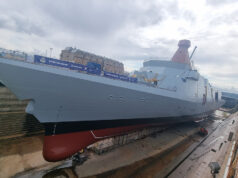


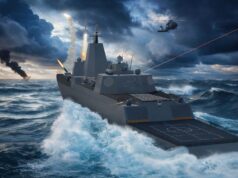
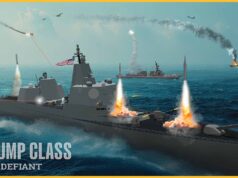
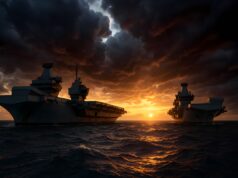
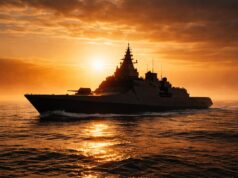

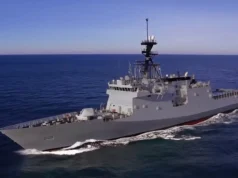

It’s one of the more overlooked factors in modern T23 crewing and the shortages is the need for two crews for the T23 forward deployed in the gulf.
However this has made it significantly easier to keep a T23 east of Suez permanently.
It actually eases the crew issue because to maintain the presence with a ship that returns home you would need three ships and three crews – one on station, one preparing to replace and one returning. You would need two ships and crews at sea a lot of the time.
Yes I agree however it does mean we need more crews than ships which has been an issue. Overall it’s a better system though for sure.
Future UK warships to have fewer crew members due to AI and other automated systems was just announced by the MOD. It can’t come quick enough and less crew means longer operational durations. With an increasing need to station more ships in the Middle and Far East, these aims will be of great use to the RN. The cost savings and availability must be a very attractive proposition going forward. I can envisage warships with a highly skilled skeleton crew possibly managing more than one vessel at a time. There may also be an opportunity to ensure T26 and 31s are refitted with advanced crew-saving systems within their lifetimes?
This issue has been raised in a recent article, with only a skeleton crew, it because a fire or flooding control, damage limitation issue.
Yes and no.
If you take the PODs concept to its logical conclusion you only need the relevant bits of crew with the relevant PODs.
So yes, you could have a core crew.
The DC aspect is very, very important but shouldn’t be used as a barrier to progress. DC requires lots of competent fit hands.
I do think there has to be a reevaluation of RNR and how it slots into RN activities and having some T31 type ships that are crewed with a core RN crew that is augmented by RNR crew.
Personally I’d find that a very interesting offer if I was a bit younger. There was a time in my life when I would have given up a month a year to do this kind of thing. The Scandi’s do that very well so it is possible.
There is a hugely experienced cadre of ex RN bods around and OK they need training on current systems. But, and it is a big but, if this is done continuously then it isn’t the massive barrier it is made out to be. The Swede’s do it – I used to live there.
These bods can already do the fundamentals and are used to life in a grey war canoe (not for everyone) and have done, say, weapons handling for other types so know the headline issues.
There is a doctrinaire approach to how RNR is used that has got to change.
All great on paper but you still need to maintain the ship and clean it. You also need to watches to fight it so don’t be so quick to start reducing crew to silly figures. A frigate needs about 120 to keep it running and to fight it. modern tech brings its own issues especially deployed when OEMs are not available.
The crewing level could be split as today with care and maintainable but fewer weapon operators and officers. A large part of current ship operations is due to a large crew and its corresponding stores and associated support rosters. A smaller crew with advanced ship monitoring would reduce risk management. Some weapon engagements could be controlled remotely, thus requiring less skilled on board. Retaining current manning is only going to worsen and remote and autonomous systems are the only long-term solution.
You are living in a different world to me. Having spent the last 43 years at sea both in the RN and MN with tech influencing more each day, reducing sizes of ship’s companies whilst desirable to reduce workforce costs leads the biggest issues and if you look at through life cost more in maintenance and cleanliness. Warships need to be able to fight which includes resupplying weapon systems and fuel. They also need the ability to have 24 watch keeping unless you are one for automatous frigates which brings a whole new concept, one we are not yet ready for yet. Finally, you need to be able to counter and damage sustained in a conflict. Accepting that is dependent on what hits you! Remember at present missiles need loading, CIWS systems can sustain very short engagements due to magazine size. What I do agree with is a two crew system to maintain ship in theatre longer. It is nice to have a proper conversation!!
Mike, my ramblings are just that and I bow to your greater knowledge. Yet sadly, the world of the drone is going to mean a huge change for our world. Size is no issue and automated warships are coming just as sail gave way to steam etc. The old ways will go as AI eradicates jobs in all sectors of life and the RN will be included. The admission by the RN that future ships will have fewer crews is a clear indicator of that fact.
Are we finally ready to see Peregrine drones flying from the ship?
This is based on the Shiebel 100 and now there’s the larger 300 model available with a greater payload and range, so why don’t they (also) try for this?
*Schiebel.
Question out to the senior service. Looking at the Mushroom farm, I have to ask was it designed from get go to be like that, oh was it an adhoc fix it, that has stayed the course. because from what I have read on here the Mk41 tubes are far superior.
No, the CAMM tubes are really old Sea Wolf tubes that were extended to accommodate the Sea Ceptor missile. The T23 hull does not have the depth for Mk. 41 to be flushed to deck, or build a raised platform on deck to accommodate and cover Mk.41 tubes.
That what the USN would have done, if the USN had brought T23 IP to build their version of T23.
Thank you,
What is a get go?
Loosely translated: from the beginning.
Beginning.
It’s another bloody Americanism… like “Lock Down”…. 🙄
Start, beginning, onset, etc.
Correct.
The Mk41 is superior in most aspects but as pointed out it can only be put on ships of a certain size due to needing to be embedded in the deck fairly deep. CAMM is a reasonably compact missile (10ft, compared to the 14ft Aster 15 and much larger 20ft American missiles) due to a variety of factors such as how it is launched. The mushroom farm is supposedly quite cheap but missiles cannot be quadpacked like the MK41, so all new ships are getting the MK41 for more missile capacity.
Mushroom farm setups could maybe be used on small, cheap ships if the RN were to ever try to pad their fleet with such ships (not likely).
Thank you
T26 has a separate Ceptor farm , as will T45 because its cheap and simple and doesnt waste valuable internal space as you would fitting a 8m long strike length VLS Mk41 and putting 3m long missiles in it. Even the shortest length variant of Mk41 is 5m so again it would waste valuable internal space. Ceptor is cold launch and so doesnt need all the hot launch gubbins that comes with the Mk41 as standard.
The silo was originally made like that to hold Sea Wolf . VL SW was around 2.5m long when delivered to the ship in its cylindrical hot launch/storage tubes that were lowered into round holes that where cut into the deck. On the deck was a flange arrangement to bolt the top of the VLSW tube down to secure it. Below decks was a magazine that the tubes sat in, where you connected the launch cables to the tubes and some bottom support mounts to secure the bottom of the VL Tubes.
Ceptor comes in a long (3m) rectangular cold launch/storage box. Its green because its exactly the same missile and launch storage tube as used by the army on Sabre. To get Ceptor onto T23 quickly with minimum rework they came up with the mushrooms. Ceptor boxes are not as wide and are longer than VLSW tubes so a smaller diameter, short cylindrical spool piece was made to permanently bolt to the deck that covers and supports the top part of the ceptor box that pokes through the deck. You lower the ceptor box into the spool piece that has a square hole in the end of it. You secure the top and the bottom of the cannister into place by a simple lock arrangement in the magazine. The magazine still functions the same to secure the launch cannisters and to allow you to connect up the cables to the launch boxes/missiles.
The T23 fit looks like it does because its a legacy of having SW fitted. On future new builds the boxes could be lowered into holes in the deck that are flush and do not require a spool piece because the height of the magazine is higher than it was for legacy SW on T23. The launch boxes can be closer together because they are not needed to be spaced as they were on a T23 because that’s again a legacy of SW hot launch tubes.
Mk41 is a hot launch system with plenum chambers to redirect launch gases and flame away from the missile as it goes whoosh. It also has a hinged door on top that must open to launch a missile. For 8 strike length (8m Long) launch tubes in a 8 cell arrangement its well north of 15mil USD and thats without any missiles .
Ceptor cold launches straight out of the box via a gas piston (Think childhood spud gun!) that throws the missile into the air before motor ignition. Once up its motor fires, it tips over and flies on its merry way. Ceptor doesn’t need plenum chambers or firefighting arrangement for a hang fire (German frigate had one with SM2 years ago…Its not a good thing) This means you don’t waste part of the rocket motor burn getting the missile out of the ship, no hang fire risk, and its quick reaction as no door is required to open. Its also a simple launcher and system that is not taking up 8m of depth and valuable internal space inside the ship for a 3m long missile.
The round mushroom tops or similar may be retained in future as these are a temporary protective cover against weather at sea and goffers. You remove them in high threat areas and leave them off. Note the army doesn’t use them on its sabre systems which are exactly the same boxes and missiles but don’t then again, they don’t experience goffers!
Hope that helps.
GB, all a good read… but what’s a “goffer”?
Waves…big hooffing waves that break over the deck
GB ,
Many thanks for a most comprehensive breakdown of “What,why,when” , regards the question.
F.
So in strike length or any tube over 6m could sea ceptor be double stacked? I know that would probably then require a harder push to get the second missile out the tube or it gets raised into place of first missile after the first one is gone or something like that.
No. The missile cannister would remain and be in the way.
The issue with the t23 is it isn’t designed for the role its been used for. Providing wide area air defence for shipping would be much better achieved with a destroyer, as it has the missile range. We just don’t have enough of them. CAMM is really only designed for defending the ship itself and any vessels it is directly escorting at close range. OK astar can’t cover the huge area involved but it can at least cover a much larger area and I’d we had kept the sentry in service I’m sure they would be flying overhead providing targeting info.
Ceptor is longer ranged that the blurb states by a considerable margin. Its system cabinets with the electronics in (the bits in the ship) can also take target data from other sensors and sources to conduct an engagement updating the missile in flight via the data link. Tracking a target using the ships radar system is a primary but not the only engagement mode you can use.
Ceptor is a 99kg missile, it will not ever be a long range missile with a 3Mach speed.
Never said it was.
What I did say is
“Ceptor is longer ranged that the blurb states by a considerable margin”
The Blur says 25Km.
I will leave it at that.
You can get more range with a more economical jet engine – read less speed – but not with a 3M one.
To risk sounding obtuse, I would say most modern Frigates/Destroyers are not equipped to deal with the most common threat in 2024, that being drones, both air and sea variants. The most common threat in 2027 will probably be missiles (when China invades Taiwan and starts flinging missiles about), which most frigates/destroyers were designed to deal with.
Missiles are not the greatest for drones cost efficiency wise. I do like the Italian destroyers with their focus on long range AA guns (the 76mm can fire ammo up to a theoretical 40km!) and the Type 31 may actually be pretty neat with their set up, and seeing as they are terrible at ASW, anti drone/anti missile is probably their best role. All of our current ships are using Phalanx with a paltry 1.5km-5.5km (effective range – max range) range, so we are forced to use missiles. Bofos 40mm can do 3.8km-7.2km and the 57mm can do 8.5km-17km so if we can see the drone it can be bopped at a comfortable range.
I hope Bofors/BAE develop more kinetic platforms to compete with the 76mm, as it is unlikely RN will buy Oto Melara when a British company sells the Bofors line. BAE made land variant of the 40mm that is towed by a 8×8 and it could serve as a cheap SHORAD imo.
I wonder if the Houthis will copy Ukraine and try to sink ships with sea drones? That is a threat existing warships will struggle with.
Italian FREMM and PPA frigates have 2x 76 or 1×127+ 1×76, so i would say they are probably the best frigates for cheap drones at moment.
Destroyers have 3x 76 , plus 2×25 in all of them. . Note 40km for 76 is against ground/surface targets in a curved trajectory with Vulcano rounds so we are not talking AA fire.
I think that any eventual war with China will include ten or hundred thousands of drones working as decoys to make the western forces waste their missiles.
Good to know on the Vulcano! Still pretty good range, though for air it seems on further reading the range is probably more like 8-10km, which is comparable to the 57mm.
It is very interesting that we are going back in time for cheap AA solutions that are coupled with developments in ammo types and tracking.
Be interesting to see what the next generation of AA destroyers will set up with.
I wonder on that. What is the cost to the country of a single merchant ship being hit. You have the loss of the cargo plus reluctance of ships to transit the area, both resulting in increased costs at home during a period where our inflation is already too high. It might be that the missile is value for money. Shells are cheaper for sure but much shorter range. A combo is really needed.
The equation of the target value is irrelevant if you don’t have the resources to produce the number of missiles necessary.
If that occurs there are no missiles anymore point.
USN already requested extra 150M$ to replenish the missile stocks due to a majority of drones with a performance that we can put inside WW2 era. This value don’t covers the number of missiles fired by USN. It is insanity.
Note also the time to build missiles is longer than build artillery rounds.
This is fair but I would reason we could get more missiles built a year than fired at the current rate of fire, so I don’t think this is an issue.
Clearly the government needs to release the funds to order them, but that applies in either scenario and considering we have hospitals collapsing on doctors and patients, it doesn’t seem the government is keen to release funds for anything.
If UK have the will certainly i agree with you. But i doubt it has.
A CAMM probably costs around 300000$, Aster 1 to 2M$
There is hundreds of billions of UK trade going through that region, so 2m seems like a bargin. For sure cheaper options are better to use, if they can be, but they have shorter range and so limit the area of protection that can be brought by a single ship and therefore limit the value brought by saving shipping.
I don’t think they can compete with the 76mm unless they make something really revolutionary.
The T23 CAMM silo image above holds 32, so you wonder if they could for the same foot print squeeze more CAMM onto the T45 than the planned 4*6=24? Sorry, I’m being repetitive, but some extra CAMM would be very useful for such a capital ship especially in a CSG carrier escort role. And even reworking the Martlet launcher trialled on the 30mm mounts. Make it smaller/lighter with 3-4 shots with better efflux control, maybe with angle pipes on the end of each tube?
The T23 farm is wasteful because it’s an adaptation of a one-to-one use of the Sea Wolf farm. We don’t know for sure what the T45’s arrangement will be and what footprint they will use, but if it’s one CAMM per silo in the same 6-silo modules we’ve seen modelled for the T26 and T31 (as you imply), then I think there’s very much an opportunity to squeeze in more. We know there is space for 16 Mk 41, so 64 quad-packed CAMM rather than 24.
I’d like to see us develop a cheaper, quad-packed-capable CAMM silo farm, rather than using ExLS that’s designed to handle hot-launched missiles.
Yes, we sure hope that they maximise the CAMM load for the usuable space and don’t just do a half job with it.
So, am I right in understanding that HMS Lancaster does not have NSM fitted yet?
Correct,she still has Harpoons.
Thanks, not really ideal in the crowded environment she’s working, but it’s something. To be fair, the likely surface targets that she’ll encounter are small vessels, so guns and Sea Ceptor should suffice. It’s not like the Iranians are going to try engaging her with a frigate…